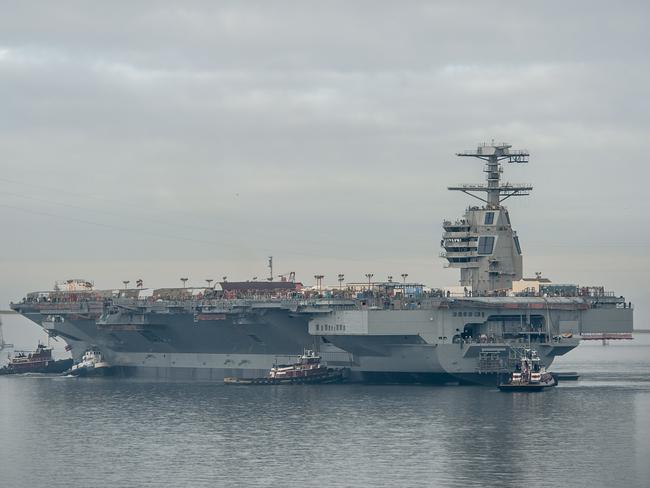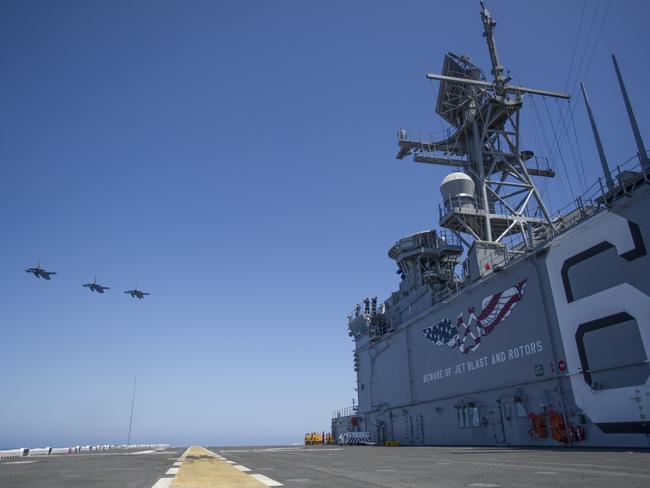Icebergs ahead for expensive US, UK aircraft carrier projects
WOULDN’T trust Australia to build a canoe? Check out the shambles the United States is experiencing with its new $17bn aircraft carrier.
WOULDN’T trust Australia to build a canoe? Check out the problems the United States is having with its new $17bn aircraft carrier.
For $US17 billion a pop ($US13 billion if somebody else is paying for the research and development costs) you’d expect some big bangs for your buck.
In the case of the US Navy’s latest and most advanced supercarrier, the glossy brochure certainly makes the promises.
It’s 100,000 tonnes of awesome at 337m long and 78m wide. Inside the 25 decks hold some 4200 officers and sailors. Two nuclear reactors are intended to power this behemoth through the water at more than 30 nautical miles an hour (56km/h).

The object of its existence is to carry its 60 combat aircraft to within range of a target, launch them, land them, refuel and repair them.
There is a problem, however.
The first of this ultra-advanced class of ships, the USS Gerald R. Ford, has been delivered to the US Navy for testing.
The never-before seen electromagnetic aircraft launch system (EMALS) appears to be a bit dodgy.
It’s still experimental, you see. At some point it was decided to incorporate this cutting-edge technology into the ship even before testing and development work was completed.
Each of the planned four catapults is supposed to use electrically-controlled and generated magnets to sling 36 tonnes of heavily laden aircraft into the air.
Ten years later the ship’s ready. The electromagnetic catapult isn’t.
Apparently, it misfires. Exactly how often is somewhat confused: the US Navy does not seem keen to reveal the latest figures. According to defence industry sources, it’s either once in every 10 slings — or one in every 240.
Given a string of failures at a recent media public relations event where weighted sleds wire shot off the ship at low-power settings, the former figure seems more closer to reality than the latter.
Even the 240 figure is scary when you take into account the supercarrier is intended to launch 120 aircraft each day. When you consider this means throwing away a perfectly good $60 million F/A-18 Super Hornet or $100 million F-35C Lightning II (and their pilots) each time, it could get real expensive real fast.
If the catapult’s manufacturer can’t get it right soon the only other option is to cut the USS Ford open, rip it out — and rebuild the ship around the old-style system.
But there’s more.
It seems aircraft cannot land on the USS Gerald R. Ford either.
Aircraft are ‘trapped’ on the deck of an aircraft carrier when hooks slung beneath their tails ‘grab’ a wire slung across the ship. A complex array of pulleys and hydraulics haul the heavy aircraft to a stop fast — but not too fast.
Once again, in the case of this super carrier it’s out with the old and in with a largely untested, unproven new concept.
Once again, the ship is ready. The arresting gear isn’t.
It reportedly has a failure rate of once in every five landings. An urgent, but untested, upgrade is being retrofitted to the ship.
If these problems aren’t fixed fast, and we’re talking by March next year, the US Navy faces a severe capability gap. Its older nuclear aircraft carriers have been used hard amid all the wars of recent decades. They’re tired. The USN also says it cannot afford to refuel and refurbish the older USS George Washington — even though it’s only half way through its designed life cycle.

An assault carrier without the assault, or the carry
The US Navy’s super carriers aren’t the only ships suffering from overoptimistic expectations.
It also appears to be the case with the USS America — an amphibious assault ship intended to support the deployment of US Marines.
Strangely, it was built without any of the usual amphibious capabilities associated with the task: The ability to carry landing craft, hover craft — or even to offload trucks and tanks to a wharf.
Instead it was built to carry F-35B Lightning II jump jets and Osprey heavy lift aircraft. It’s really just an aircraft carrier going under another name.
The 45,000 tonne warship was accepted into service amid the usual fanfare last year.
It since turns out the ship isn’t really ready — and neither are the aircraft.
The USS America is back in dock having her deck pulled apart. It was discovered it couldn’t handle the heat generated by landing F-35s and Ospreys.
The B variant of the F-35 is designed for short takeoff and vertical landing: It lands by directing the full force of its jet engine downward. It appears this can burn through decks.
Why this is a problem is yet to be fully explained: The USS America was supposedly designed specifically to operate the F-35B.
The fix, reportedly, will never be complete. This aircraft carrier will permanently have limits on how may F-35B Lightning IIs and Ospreys it can land each day.
As the Lightning II is not yet ready to go to sea, the USS America will have to contend with only the Osprey’s down draft for the foreseeable future.

Britain waves goodbye to ruling the waves
The US isn’t the only nation struggling to find reality among defence industry marketing and politics.
The first of Britain’s two Queen Elizabeth class aircraft carriers is due to be handed over next month.
It’s the first time in three decades that the proud seafaring nation has had a ‘real’ aircraft carrier. The three Illustrious-class ships it recently scrapped were designated ‘through-deck cruisers’ to fool politicians into thinking they were cheaper than the real thing.
But there is a problem.
This huge new carrier is not fitted with a catapult. Nor does it have arrestor wires.
It’s a choice made to save money: Even the old versions of these technologies don’t come cheap.
This shouldn’t have been a problem when it came to Queen Elizabeth’s intended air group — F-35B Lightning II short take off, vertical landing fighters.
Problem is, these aircraft are almost a decade behind schedule. No operational examples have yet been delivered and many technical hurdles are yet to be overcome.
For the UK, there is no fallback. Britain’s force of Sea Harriers and RAF ground-attack Harriers have long since been scrapped: To save money.
And its small force of Typhoon combat jets isn’t designed for use on aircraft carriers. Even if they were, they’d need a catapult and arresting wires …
The end result? Two enormous aircraft carriers without aircraft, for the foreseeable future at least.




